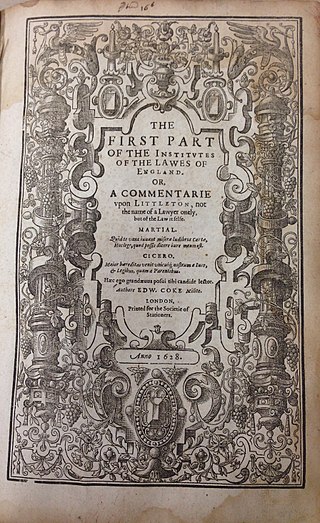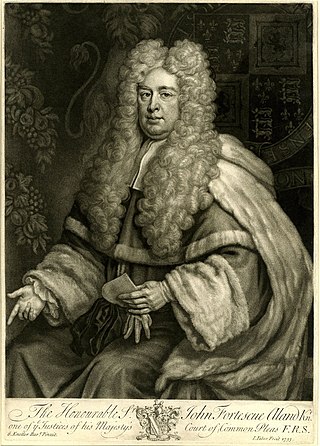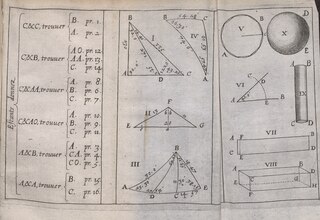
Thomas Campion was an English composer, poet, and physician. He was born in London, educated at Cambridge, studied law in Gray's inn. He wrote over a hundred lute songs, masques for dancing, and an authoritative technical treatise on music.

Sir John Fortescue of Ebrington in Gloucestershire, was Chief Justice of the King's Bench and was the author of De Laudibus Legum Angliae, first published posthumously circa 1543, an influential treatise on English law. In the course of Henry VI's reign, Fortescue was appointed one of the governors of Lincoln's Inn three times and served as a Member of Parliament from 1421 to 1437. He became one of the King's Serjeants during the Easter term of 1441, and subsequently served as Chief Justice of the King's Bench from 25 January 1442 to Easter term 1460.

Law French is an archaic language originally based on Old Norman and Anglo-Norman, but increasingly influenced by Parisian French and, later, English. It was used in the law courts of England, beginning with the Norman conquest of England in 1066. Its use continued for several centuries in the courts of England and Wales and Ireland. Although Law French as a narrative legal language is obsolete, many individual Law French terms continue to be used by lawyers and judges in common law jurisdictions.

The Norman yoke is a term denoting the oppressive aspects of feudalism in England, attributed to the impositions of William the Conqueror, the first Norman king of England, his retainers and their descendants. The term was used in English nationalist and democratic discourse from the mid-17th century.

William Lambarde was an English antiquarian, writer on legal subjects, and politician. He is particularly remembered as the author of A Perambulation of Kent (1576), the first English county history; Eirenarcha (1581), a widely read manual on the office and role of justice of the peace; and Archeion, a discourse that sought to trace the Anglo-Saxon roots of English common law, prerogative and government.

The Old English Latin alphabet generally consisted of about 24 letters, and was used for writing Old English from the 8th to the 12th centuries. Of these letters, most were directly adopted from the Latin alphabet, two were modified Latin letters, and two developed from the runic alphabet. The letters Q and Z were essentially left unused outside of foreign names, while the letter K was used by some writers but not by others. The Middle English manuscripts Stowe MS 57 and Cotton Titus D 18 do not present the letters in the exact same order, but both place the non-standard Latin letters at the end of the alphabet.
The Stationers' Register was a record book maintained by the Stationers' Company of London. The company is a trade guild given a royal charter in 1557 to regulate the various professions associated with the publishing industry, including printers, bookbinders, booksellers, and publishers in England. The Register itself allowed publishers to document their right to produce a particular printed work, and constituted an early form of copyright law. The company's charter gave it the right to seize illicit editions and bar the publication of unlicensed books.

The Selden Society is a learned society and registered charity concerned with the study of English legal history. It functions primarily as a text publication society, but also undertakes other activities to promote scholarship within its sphere of interest. It is the only learned society wholly devoted to the topic of English legal history.

Britton is the earliest summary of the law of England in the French tongue, which purports to have been written by command of King Edward I.

Rawżat aṣ-ṣafāʾ fī sīrat al-anbiyāʾ w-al-mulūk w-al-khulafāʾ or Rawdatu 's-safa is a Persian-language history of the origins of Islam, early Islamic civilisation, and Persian history by Mīr-Khvānd. The text was originally completed in seven volumes in 1497 AD; the eighth volume is a geographical index. The work is very scholarly, Mīr-Khvānd used nineteen major Arabic histories and twenty-two major Persian ones as well as others which he occasionally quotes. His work was the basis for many subsequent histories including the works of Hajjī Khalfah.

The Institutes of the Lawes of England are a series of legal treatises written by Sir Edward Coke. They were first published, in stages, between 1628 and 1644. Widely recognized as a foundational document of the common law, they have been cited in over 70 cases decided by the Supreme Court of the United States, including several landmark cases. For example, in Roe v. Wade (1973), Coke's Institutes are cited as evidence that under old English common law, an abortion performed before quickening was not an indictable offence. In the much earlier case of United States v. E. C. Knight Co. (1895), Coke's Institutes are quoted at some length for their definition of monopolies. The Institutes's various reprinted editions well into the 19th century is a clear indication of the long lasting value placed on this work throughout especially the 18th century in Britain and Europe. It has also been associated through the years with high literary connections. For example, David Hume in 1764 requested it from the bookseller Andrew Millar in a cheap format for a French friend.

Robert Hues was an English mathematician and geographer. He attended St. Mary Hall at Oxford, and graduated in 1578. Hues became interested in geography and mathematics, and studied navigation at a school set up by Walter Raleigh. During a trip to Newfoundland, he made observations which caused him to doubt the accepted published values for variations of the compass. Between 1586 and 1588, Hues travelled with Thomas Cavendish on a circumnavigation of the globe, performing astronomical observations and taking the latitudes of places they visited. Beginning in August 1591, Hues and Cavendish again set out on another circumnavigation of the globe. During the voyage, Hues made astronomical observations in the South Atlantic, and continued his observations of the variation of the compass at various latitudes and at the Equator. Cavendish died on the journey in 1592, and Hues returned to England the following year.

John Fortescue Aland, 1st Baron Fortescue of Credan, of Stapleford Abbotts, Essex, was an English lawyer, judge and politician who sat in the House of Commons for two years from 1715 to 1717. He wrote on English legal and constitutional history, and was said to have influenced Thomas Jefferson. A member of both the Middle Temple and Inner Temple, he became a King's Counsel in 1714 and was then appointed Solicitor General, first to the Prince of Wales and then to his father George I in 1715. After a short stint as a Member of Parliament, Fortescue Aland was knighted and elevated to the Bench as a Baron of the Exchequer in 1717. He was subsequently a justice of the Court of King's Bench (1718–1727) and of the Court of Common Pleas (1728–1746), save for a brief hiatus between 1727 and 1728 which has been attributed to George II's displeasure with one of his legal opinions.

Historia Placitorum Coronæ or The History of the Pleas of the Crown is an influential treatise on the criminal law of England, written by Sir Matthew Hale and published posthumously with notes by Sollom Emlyn by E. and R. Nutt, and R. Gosling, for F. Gyles, T. Woodward, and C. Davis in 1736. The book was published despite an instruction in Hale's will that none of his manuscripts was to be printed after his death unless he had ordered the publication during his lifetime. This was defended by Emlyn on the basis that it was a work of enormous importance; that he appeared to have revoked this instruction in a codicil; and that, in any event, it was obvious that he had intended to publish it. He further observed that the order was the result of fear that the text would be altered or abridged.
De Iniusta Vexacione Willelmi Episcopi Primi is a late 11th-century historical work detailing the trial of William de St-Calais, a medieval Norman Bishop of Durham from 1081 to 1096. It is the first surviving detailed account of an English trial before the king, and as such is an important source for historians.

Edmund Wingate (1596–1656) was an English mathematical and legal writer, one of the first to publish in the 1620s on the principle of the slide rule, and later the author of some popular expository works. He was also a Member of Parliament during the Interregnum.

Andrew Horn was a fishmonger of Bridge Street, London, lawyer and legal scholar.

Mary Isabella Hales Horne was a prominent leader in many different capacities in the Church of Jesus Christ of Latter-day Saints. During her lifetime she served as a Relief Society president at the Ward and Stake levels. She also made her voice heard with regards to the federal restraints on polygamy and women's rights.

This Is the Boke of Cokery, or The Boke of Cokery, is believed to be the first cookery book printed in English. The name of the author is unknown. It was printed and published by Richard Pynson in 1500. The book remained in print for many years in the 16th century, but was superseded and forgotten by the 18th. The only known surviving copy of the book is in the possession of the Marquess of Bath at Longleat House, Wiltshire.


















